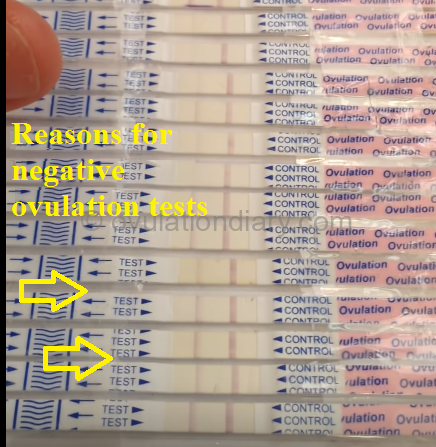
The most popular ovulation test “catches” a jump of the luteinizing hormone (LH) in the urine. In 6-48 hours after the LH increase the egg is released and a woman starts being able to conceive. A positive ovulation test result is one where the test strip is the same color as the control or brighter.
What does the ovulation test show
Ovulation is the moment when a follicle rips in the ovary and the egg is ready for fertilization. This process starts a sharp jump in LH in the body of a woman, when the amount of the hormone in the blood becomes 21.9-56.6 mU / ml. This exact uptick is what the ovulation test tracks. During the next two days after the rise of LH, follicle rupture occurs.
The luteinizing hormone enters first the bloodstream and then into the urine. If urine contains a lot of LH (above the threshold level of the test strip) – the ovulation test will give a positive result.
![]() Interesting to know(!): If today your test strip is positive, this does not mean that ovulation has occurred. It will happen today, tomorrow or the day after tomorrow.
Interesting to know(!): If today your test strip is positive, this does not mean that ovulation has occurred. It will happen today, tomorrow or the day after tomorrow.
Most fabricators may have a threshold level, that is, the sensitivity of the ovulation test, about 20-30 mIU/ml. The lower this number is, the more clear the test strip appears.
![]() Attention(!): If the second strip is not as bright as the control one or is quite absent, this is a negative test result (here is its main difference from the pregnancy test). There will be no ovulation during the next 24 hours. It is surely upon condition of abidance by simple testing rules.
Attention(!): If the second strip is not as bright as the control one or is quite absent, this is a negative test result (here is its main difference from the pregnancy test). There will be no ovulation during the next 24 hours. It is surely upon condition of abidance by simple testing rules.
Detailed instructions for ovulation test performance
The date of the testing’s start is usually defined as follows: the number of the cycle’s days minus 17. It is necessary to carry out the procedure every day at the same time (± 30 min.) From 10 am to 8 pm.
Tips for the right test performance are the following:
- Abstain from urinating 4 hours before the test. This is easier if you drink just a little bit of liquid, not more than 0.5 cup.
- Prepare a clean and dry container for urine (the most convenient is a small plastic cup for alcohol), also a mobile phone or a watch. If you use test systems or cassettes that can be placed directly under the stream, you do not need to prepare the container.
- Before testing, collect the urine and unpack the box. It is better to do the test at the first onset, of the fresh urine (this way the reagents work better).
- According to the instructions check the seconds’ number of the steep into the urine (or of the placing under the stream), the features of testing, as well as the length of wait of the result.
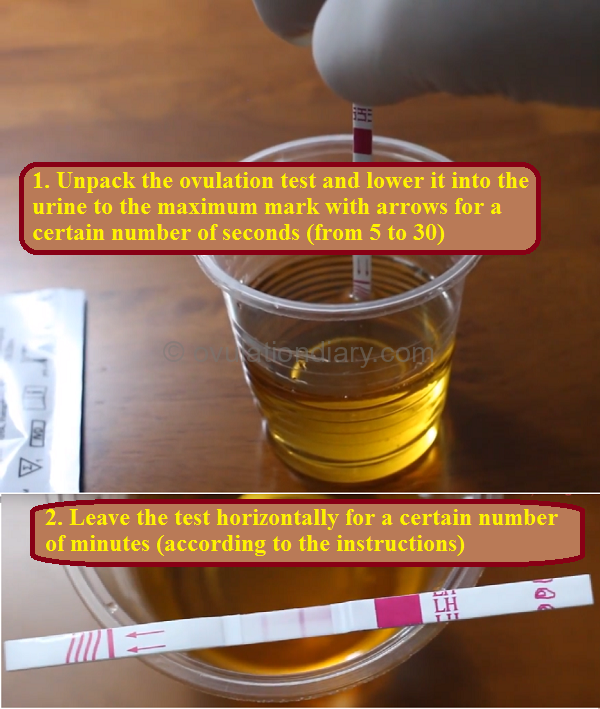
- Open the individual packaging of the test strip and steeper it in the urine for the number of seconds recommended by the fabricator (this can be 5-30 seconds) up to the MAX mark. After that, lay the test strip horizontally on the clean, dry surface for the required number of minutes (1-20 minutes according to the instructions).
- Evaluate the result. Take a picture of the test before the test zone has dried up. After drying, the brightness and fat content of the bands may change slightly. Typically, the fabricator indicates in a note: «Do not evaluate the result after XX minutes».
- Continue daily testing (preferably 2 times a day) until a negative result appears after a positive test, and you feel the signs of occured ovulation (see below).
This is how the level of LH increases gradually in the urine. According to this, the test strip brightens a little:
When a hormone jump occurs, the second strip becomes as saturated as the control one (or even brighter).
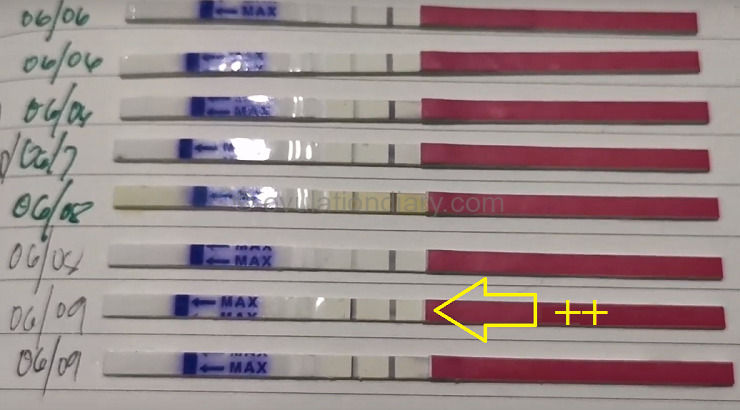
On the next day after ovulation, the test becomes negative. After oocyte release, there is no longer a need for such an amount of LH in the body and its level drops.
Here is the photo where the ovulation test is first negative, then positive, and then negative again:
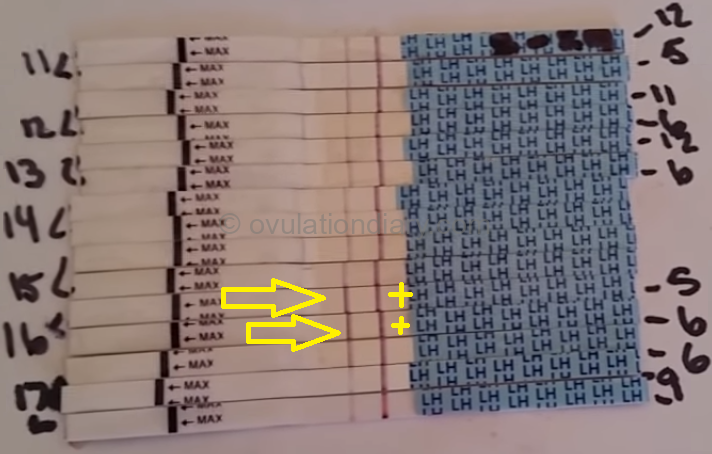
How many days is an ovulation test positive?
As long as the increase of the LH level lasts. The graph of jump in the luteinizing hormone for different women can have a completely different look. Because of that, pattern of the strips’ brightness on the test in the pre-ovulatory period will be different.
In other words, ovulation tests can be positive for a different number of days. In most cases, positive results are observed 1-2 days in one menstrual cycle (but not more than three days!).
Below I give several different types of graphs of the level changes of LH, created on the basis of studies of the magazine “Fertility and Sterility” and the corresponding test staining schemes:
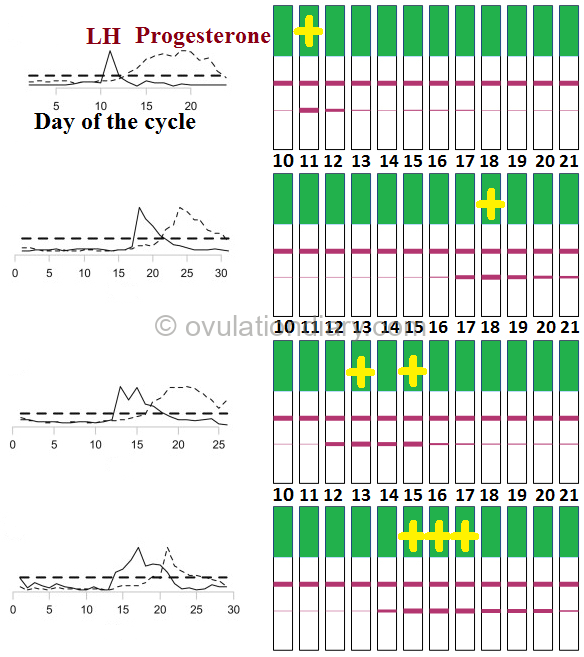
All of these options demonstrate the normal functioning of the reproductive system and the onset of pregnancy is quite possible.
When does ovulation occur after a positive test?
A lot of women have the start of the ovulation within 6-48 hours after the last positive ovulation test.
For example, if two equally bright strips were on the 16th and 17th DC, then ovulation is likely to occur from the 17th to the 19th day of the cycle.
Shortly before the egg releases, most women notice a change in cervical fluid: it becomes more fluid, transparent and mucous, like the egg white.
During ovulation, many a one will feel pain in one of the ovaries or in the lower abdomen. Pain feelings may also occur in the lower back or rectum – it all depends on the individual physiological characteristics of the woman and her pain threshold.
Unreasonable sicchasia can also accompany ovulation. Details about all the signs and symptoms of ovulation can be found on this site.
The test for ovulation is positive, but there is no ovulation then
So, if the ovulation tests stably show the peak of LH, and pregnancy does not occur within 6 months – it is recommended to do an ultrasound.
There are some cases when the ovulation test gives a positive result, but the follicle does not burst and does not release the egg, although the basal temperature seems to rise and the periods occur in the expected period.
There are three explanations for this phenomenon:
- A premature burst of LH occurred when the dominant follicle had not yet reached the desired size of 18-23 mm. Most likely, a new jump in LH will occur a little later and then the follicle will burst and release a mature egg. It is important to continue with regular intimacies until you are sure that the second phase has begun (BBT will rise by 0.3-0.5 °C or 0.54–0.9 °F compared to the first phase).
- Polycystic ovary syndrome, when there are bursts in the level of LH, after which there is no rupture of the follicle. Diagnosed by ultrasound.
- Luteinization of the neovulated follicle (LNF). In this case, the level of hormones is normal, but there is no release of the egg. Although the yellow body does not form, the luteinized dominant follicle is involved in the production of progesterone instead. Detection of LNF is possible only by ultrasound.
![]() Interesting to know(!): According to statistics, from 6 to 25% of all cases of infertility are associated with the presence of LNF. There is evidence that prolonged use of anti-inflammatory drugs can cause this problem. For example, in the treatment of autoimmune diseases, endometriosis or arthritis, there is a risk of LNF developing.
Interesting to know(!): According to statistics, from 6 to 25% of all cases of infertility are associated with the presence of LNF. There is evidence that prolonged use of anti-inflammatory drugs can cause this problem. For example, in the treatment of autoimmune diseases, endometriosis or arthritis, there is a risk of LNF developing.
If the ovulation test is negative all the time
Here are some explanations as to why there are no positive ovulation test results:
- There has been no ovulation yet. Especially often, the wrong start of testing happens among the women with an irregular cycle or oligomenorrhea (rare periods).
- Anovulation (ovulation absence). It may be physiological, for example, ovarian rests for 2-3 cycles a year, among women 35+ the number of ovulatory cycles gradually decreases, breastfeeding, pregnancy, and pathological, for example, with polycystic ovarian syndrome (POS), hyperandrogenism, impaired thyroid function, etc.
- Bad test or breaking during the performance of tests. Curious to relate, this is also a common cause of difficulty in detecting ovulation using the test strips. Try several different fabricators (it is possible if they are inexpensive), make sure that the period of validity is not violated. Do not use night or morning urine (LH is recommended to “catch” after 10 am and until 8 pm). Do not drink a lot of water before testing, and it is recommended not to urinate for 4 hours beforehand.
- A false negative result, when in fact the jump has occurred, but due to the low concentration of LH in the urine, the test produces a pale second strip. In paragraph 3, several reasons for the decrease in the sensitivity of the test are already described: poor quality of the product and breaking of the testing technique. In addition, a false negative result can provoke kidney problems or an increased level of the protactinium hormone (for example, during breastfeeding).
If during three running cycles you do not manage to catch ovulation with the help of tests, I recommend to contact your gynecologist.
Ovulation test is positive – when to start planning
As soon as you get a positive result, you can begin active actions. Intimacy on the day of ovulation and one or two days before has a greater chance of ending in pregnancy.
![]() Attention(!): The recommended interval between SC (sexual congress) is 2-3 days. This is especially important if there are difficulties with the number and motility of sperm (seen on the spermogram).
Attention(!): The recommended interval between SC (sexual congress) is 2-3 days. This is especially important if there are difficulties with the number and motility of sperm (seen on the spermogram).
For example, if you had your intimacy on the day of a positive ovulation test, it is better if the next SC would be one day after, then another day later, and so on till the signs of occurred ovulation will appear: pain in breast or fluid-filled breast, increased BBT, body temperature above 37 °C (98.60 °F), the disappearance of secretions by type of protein.
More information about intimacy before and after ovulation is in a separate article with examples and recommendations.
Special digital ovulation test for impregnation of a girl
Spermatozoa carrying the female X chromosomes are known to be slow, but more tenacious of life. The male sperm are faster, but quickly depleted and die. This is the second most reliable method of planning the sex of the child after directly manual selection of sperm by a specialist of the reproduction center.
If intimacy happens more than 2 days before ovulation – with a high probability there will be a girl. What then should be done with ovulation tests showing the approaching period of high fertility only on the next day or two?
In this situation, the best test option is the one that “catches” the jump of two hormones at once: LH and estrogen. This electronic test system will show the approaching of the ovulation 3-4 days before, that is, at the best time for impregnation of a girl. It is called the Clearblue Advanced Digital Ovulation Test.
Most women have rising estrogen levels, which begin to rise 3-4 days before ovulation. When this happens, the test shows a flashing smiley face. To plan a girl, you should plan for intimacy just on the days of a flashing smiley face.
As soon as a static smiley face appears, you must stop having unprotected sexual intercourses.
![]() Note(!): You may order this test on Amazon or Walmart. These are large proven online stores with the ability to deliver goods to various countries of the world.
Note(!): You may order this test on Amazon or Walmart. These are large proven online stores with the ability to deliver goods to various countries of the world.
There is a separate article about various ways of calculating the ideal period for planning a girl.
What is the best ovulation test
Generally cheap and expensive ovulation test strips have no difference. The price is determined by the brand, the width of the test surface, as well as the presence of additional “buns”, such as containers, for collecting urine.
![]() Note(!): The most low-budget test strips are very narrow, but you can recognize a positive result.
Note(!): The most low-budget test strips are very narrow, but you can recognize a positive result.
The only thing is, choose tests with a sensitivity of 20-25 mIU/ml, as some women may have a peak LH of only 22-25 and the test strips with a sensitivity of 30 mIU/ml will never stain quite brightly. That is why so many women complain about the lacking brightness of the strips, for example, with the brand Frautest.
If the financial muscle allows, choose digital devices to determine ovulation, then you will not need to have an issue with the analysis of the strips’ saturation.
In a case of long or irregular cycles, when you need a lot of tests, you can order large batches of cheap test strips (50-100 pcs.) Via the Internet (there is a separate section with my recommendations for ordering).
In conclusion, I’ll add that it is not the brand and price of the ovulation test that matters, but how correctly it was stored and used. You can catch the beginning of the fertile period using the simplest test.
I recommend starting pregnancy tests 10 days after a positive ovulation test or the day after the first early signs of pregnancy appearing. Remember that positive results for more than three days in one cycle or the absence of a positive result for more than three menstrual cycles in a row is an occasion to consult a doctor.
I wish you a Big Fat Positive and happy pregnancy!

